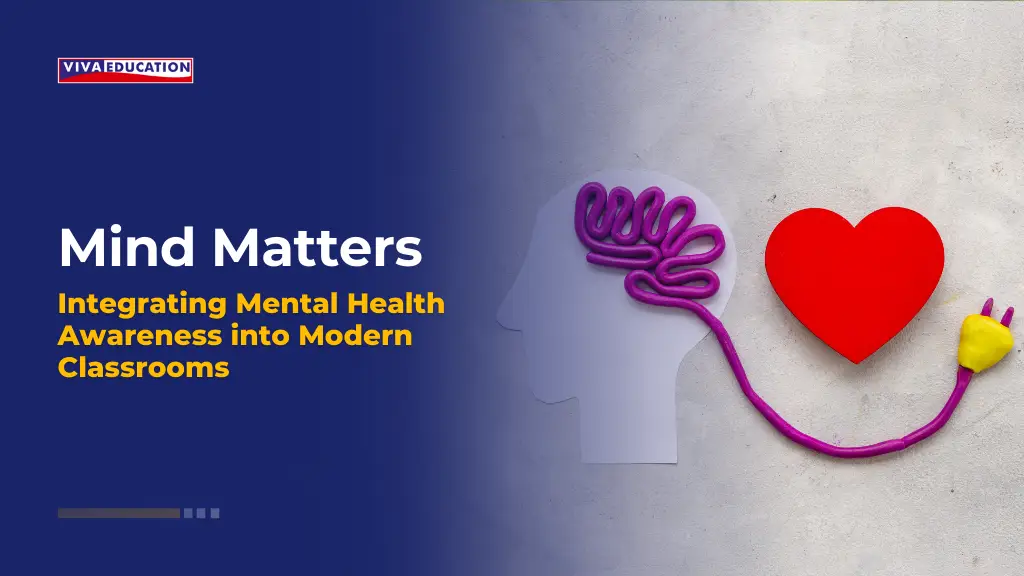Mind Matters: Integrating Mental Health Awareness into Modern Classrooms
- Schools
- October 18, 2024
- Viva Education

Students today are grappling with stress, anxiety, and emotional struggles, often due to the pressures of schoolwork, social expectations and an increasingly competitive environment. With packed schedules and high demands, mental health issues in children can arise from feeling overwhelmed, isolated, or unable to cope with the stress they experience. But what if schools became safe spaces that prioritised emotional well-being?
Integrating mental health into education can boost students’ confidence, improve academic performance, and teach them vital coping skills. When students develop emotional resilience and self-awareness, they become better equipped to handle real-world challenges, build healthier relationships, and contribute meaningfully to their communities.
What is Mental Health Awareness in Education?
Mental Health Awareness in Education recognises the prominence of a learner’s mental well-being as an integral part of their development. It sheds light on the importance of building a safe space for learners to express their emotions and challenges. Emphasise the need for a nonjudgmental environment in educational institutions like schools, colleges, etc.
Why is addressing Mental Health important in education?
Growing awareness about mental health has made us realise that an individual’s mental and emotional well-being contributes equally to their success as their physical well-being. For a learner to perform efficiently, his ability to think and interact rationally stems from sound mental health. A stable mind is open to new opportunities and growth.
According to the World Health Organization, one in seven individuals between the ages of 10 and 19 years face some form of mental disorder, proving to be a core reason for other diseases in this age group.
Increasing Focus on Mental Health in Schools
The school has evolved from a place of education to an institution of a learner’s holistic development. The concept of holistic development focuses on supporting an individual’s progress beyond educational aspects. It includes being physically fit, having good intellect, and having social and emotional skills.
Learners spend a considerable amount of time in their lives in the school. The environment of an educational institution also plays a vital role in a learner’s mental health. They serve to form the base of every learner’s personality. As such, schools and colleges must incorporate mental health programs and resources.
In a healthy educational setting, learners can speak freely while accepting constructive feedback. Each one must feel included in the environment. This Integration of Mental Health Awareness in Education:
- Thrives confident learners.
- Encourages social and emotional learning of learners.
- Upgrades learner’s academic performance.
- Helps with early identification and solution to any mental health problems in learners.
Approach:
Teachers can help students understand and strengthen their social and emotional skills through:
- Designing strategies for coping and regulating emotions within classrooms and social settings.
- Teaching students to be self-aware and understand their emotions.
- Training them with stress management techniques like meditation, slow breathing etc.
- Encouraging discussions about mental health and considering the unique approaches of every learner.
- Enlightening them about the connection between mind and body is the key to wellness.
Role of Teachers and Educators as Mental Health Advocates
After family, teachers are the people who understand students the best. They know and understand the behavioural responses of every student. Hence, they can quickly identify any changes in their behaviour. The changes in behaviour can be temporary and subjective to a student. However, the symptoms of deteriorating mental health stand out differently. Let’s take a look at some examples:
- A student who used to participate in the classroom sessions actively prefers to stay quiet now.
- A learner who was always the first to stand for any extra-curricular activity chooses to stay aloof or continuously perform poorly.
- A talkative and socialising student refraining from interacting much.
These are common signs and symptoms; early detection can prevent serious repercussions. Schools can set up support resources for students going through mental health issues by:
Providing Mental Health first-aid
Like physical first-aid, mental health first-aid is also very crucial in cases of deteriorating mental health or a mental health crisis. It is put into use until the individual in concern is out of the state or has access to a mental health professional.
Resources
- Counselling Service: Provide learners with the facility to access quality counselling services in case of a mental health issue. This necessitates a personalised safe space for learners to express themselves freely. In turn, counsellors may help them develop coping strategies to deal with the problem.
- Stress Management Techniques: Teaching learners effective stress management techniques like staying physically active through exercise and yoga. They can also practise mindfulness through meditation.
- Regular workshops: Conduct workshops and educational programs about mental health awareness and self-care. This enlightens learners about concepts and methods for managing differences in daily life.
Parent-School Collaboration on Mental Health
When parents and schools come together to support a child’s mental health, it creates a caring, supportive space where students feel genuinely understood. Open communication between parents, teachers, and mental health professionals helps everyone get a clearer picture of the child’s emotional needs and how to improve things at school and home.
Parents can share important insights about their child’s behaviour and, together, ensure that any coping strategies are working. By teaming up, parents and schools can create an environment where students feel safe, supported, and able to grow emotionally and academically.
Destigmatising Mental Health Issues Among Young Learners
A significant barrier to Mental Health Awareness is the stigma around it. Learners may have a natural fear of being perceived differently or have previous experiences of invalidation, which creates stigma. This stigma can come from family, school or community. Thus, breaking the stigma and forming a society that acknowledges and supports mental health is essential.
How to break the stigma?
- Mental Health issues may start to appear in children aged 5 to 6 years old in some form or another. This implies cultivating awareness about mental health from a young age through educating them about its signs and symptoms.
- Embracing open discussions surrounding mental health at homes, educational institutions and the community. Fostering a safe environment where learners struggling with mental health problems don’t feel discriminated against.
- Conducting mental health campaigns to widen perspectives about mental health.
- Attending to the needs of the struggling learners with empathy and compassion.
- Mindful usage of words while interacting with struggling learners.
- Validating their emotions and experiences through personal anecdotes.
Impact of breaking the stigma
- Less fear and more acceptance will stimulate a growing community where peers help each other without judgment.
- It will also boost education in mental health, and better instruments for managing emotions and stress will become public knowledge.
Programs that teach students how to handle stress and setbacks in a healthy way
Besides techniques learnt through education and mental health services, students can also try their hands on programs that help regulate emotions and build valuable life skills. Here are some courses offered by Coursera:
1. Managing Emotions in Times of Uncertainty & Stress: This program provides brief information about stress-coping methods and sharpening social and emotional skills.
2. Tools and Techniques for Managing Stress: This course encompasses basic to intermediate knowledge about stress and effective management techniques.
3. Managing Stress and Time: This course will balance a learner’s chaotic schedule and teach the art of working time. It also covers ideas on tapping stress points in real-time, reducing their impact in becoming a bigger problem.
Global Examples of Mental Health Initiatives in Education
Countries
Shanghai has initiated an advisory system to take care of the mental health problems of young learners. It consists of advisors who are supposed to examine any mental health problems students might face. They engage with students daily and help prevent mental health problems. In case a learner identifies with a mental health disorder, advisors can assist with quality referrals to mental health services. This system is being actively practised in nearly 200 schools in Shanghai
Institutions
The National Center for School Mental Health (NCSMH) has been active in contributing to mental health services globally. It is located at the University of Maryland School of Medicine and consists of experts who were engaged in the creation and review process of WHO’s manual development programme for mental health services.
These global examples set benchmarks for schools of other nations to learn from in uplifting students’ learning environments. By identifying socio-economic factors in the local context and aligning educational policies with global norms, barriers to an effective and healthy learning environment can be recognised and eradicated.
The Future of Education
By prioritising mental well-being, we’re improving academic success and giving students the tools they need to handle life’s challenges with confidence and resilience. As schools worldwide embrace this shift, we’re creating safer, more compassionate environments where every child feels supported.
With the global behavioural health market set to reach $245 billion by 2027, parents and schools are coming together to use technology to nurture students’ emotional growth. Together, we’re building a future where every child can flourish, both in school and life.



